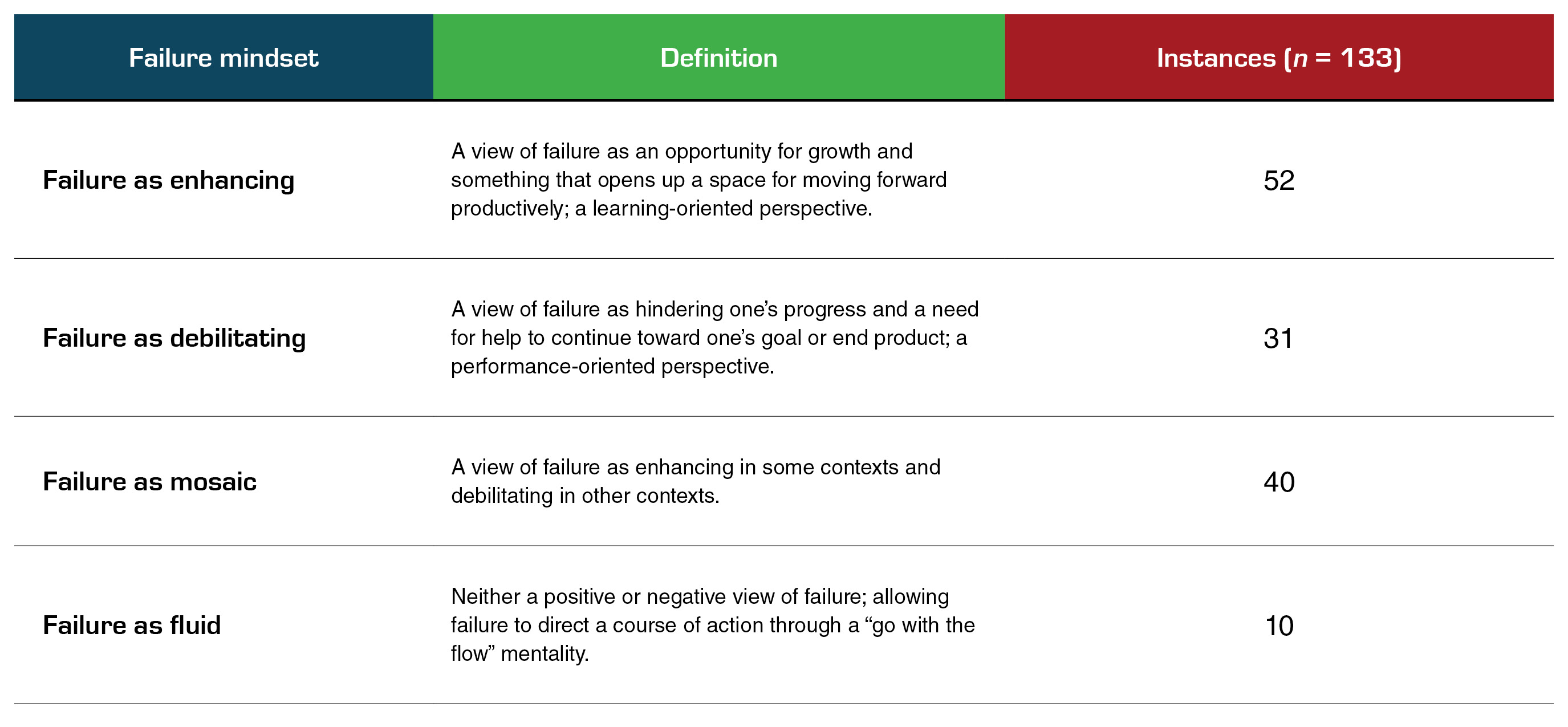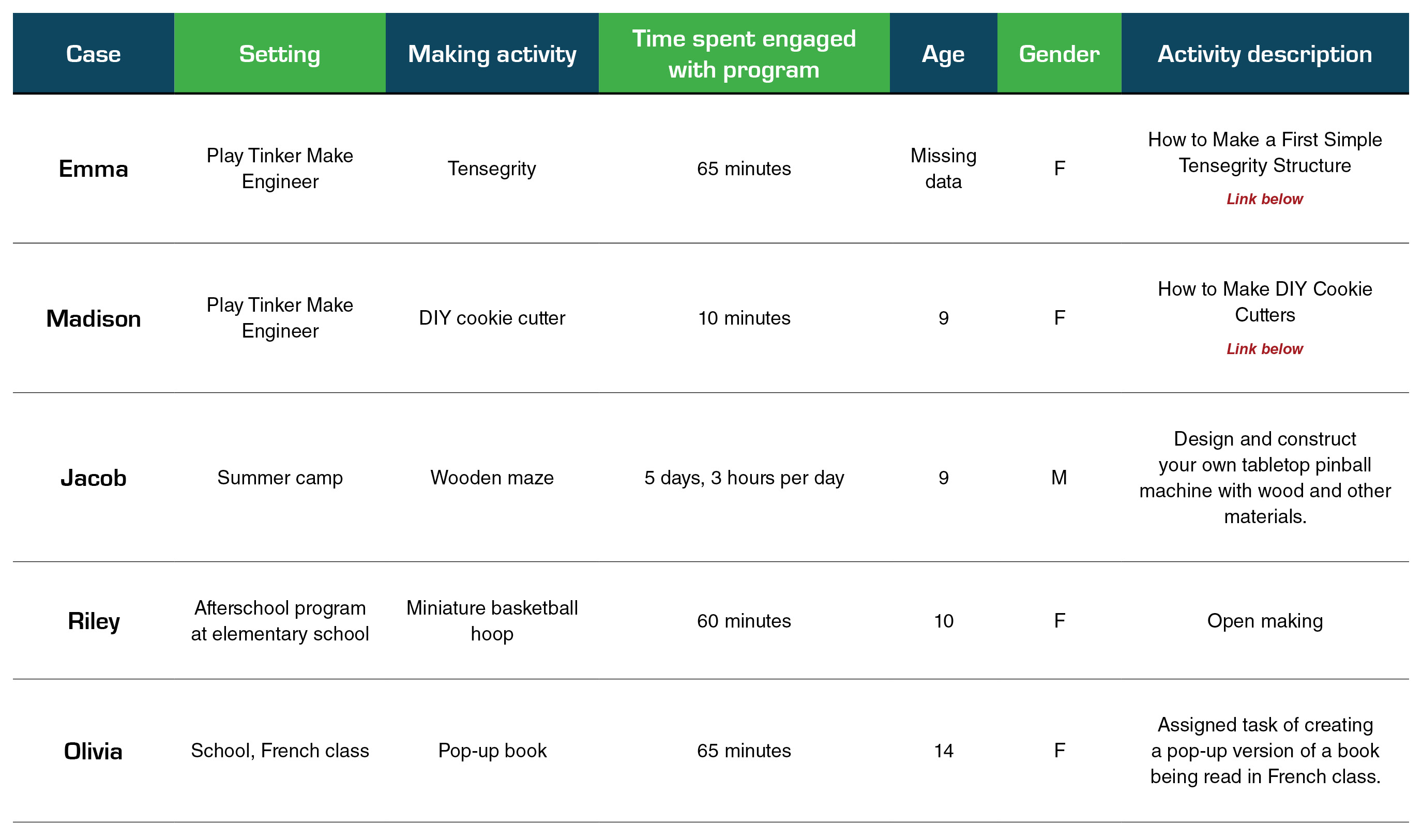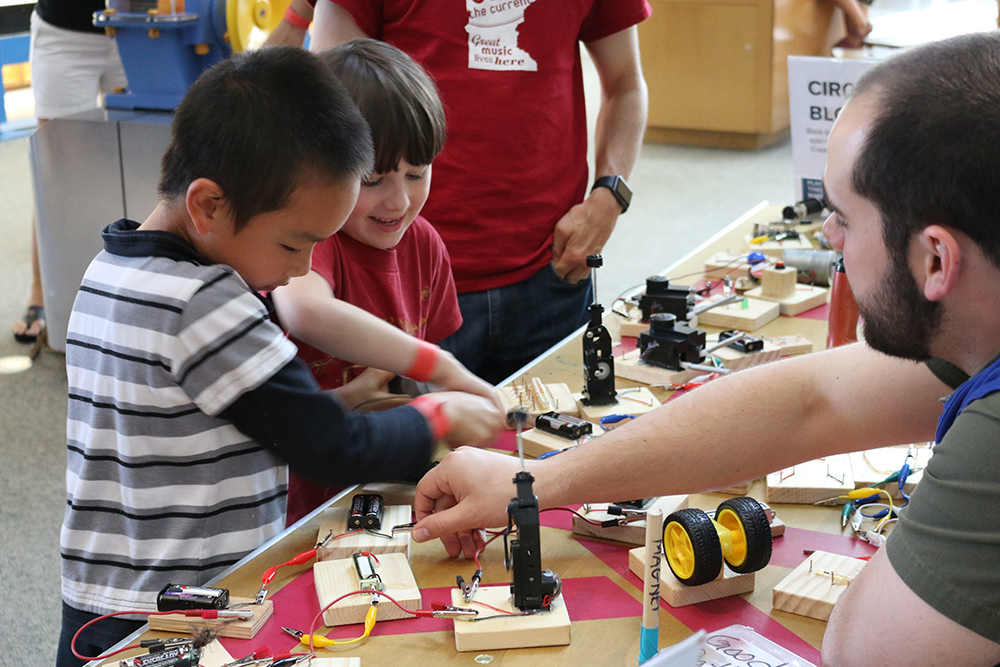Research to Practice, Practice to Research
Where Should Learners Struggle?
Developing a Failure Mindset Through Maker Activities
Connected Science Learning October-December 2019 (Volume 1, Issue 12)
By Alice Anderson, Megan Goeke, Amber M. Simpson, and Adam V. Maltese
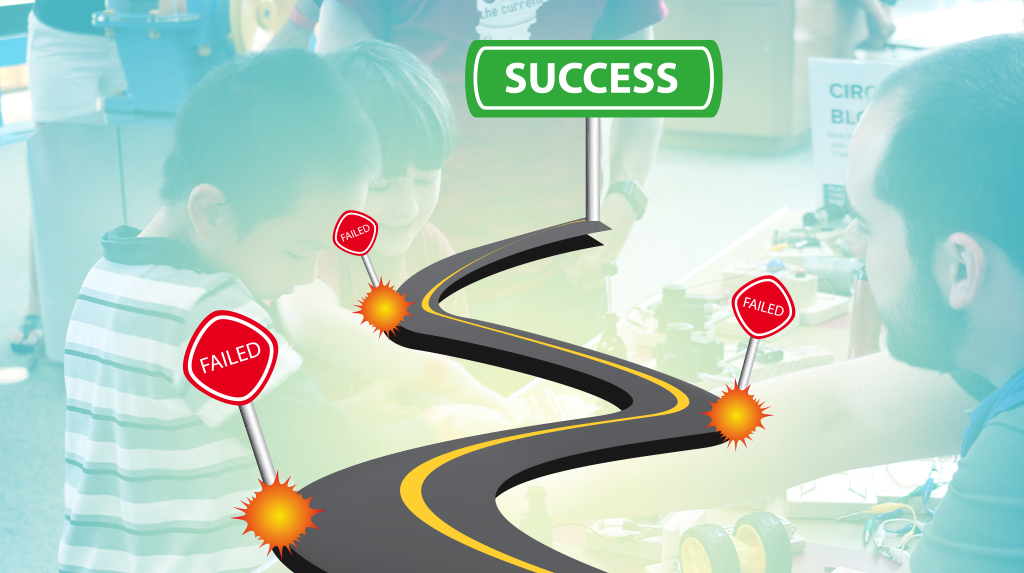
"I’ve had one cohort of kids…They were with me last year and then they came back and did a more advanced maker club this year, and so the way that they approached these challenges is so different. They have this mindset where they need to plan and then [confer] and then make a first prototype. And when they see that that’s not good enough, they’ll go back to the planning board…Whereas the kids that are new to the club—I’ve done a lot of hand holding with them towards the making, even, because they get to this obstacle and just give up.” —Teacher, maker program in an elementary school education setting
Educators, researchers, and STEM professionals identify a need for youth to develop persistence—continuing to attempt something in the face of challenges—and a growth mindset, which is an individual’s internal belief that intelligence and skill grow over time and are not innate to be successful in life, academics, and careers (NRC 2014; Simpson and Maltese 2017; Dweck 2006; Dweck, Walton, and Cohen 2014; Lahey 2016). Various learning designs for increasing persistence have been proposed, notably around “productive failure,” wherein learners are presented with novel, complex tasks they likely cannot solve before receiving instruction (Kapur 2008). Building on the work around persistence and growth mindsets is an emerging interest in “failure mindsets,” which describes the degree to which an individual views failure as enhancing or debilitating, and its impact on career, educational, and health outcomes (Haimovitz and Dweck 2016; Kwak 2018; Henry et al. 2019; Penzel et al. 2016). Other lines of inquiry have shed light on some overwhelmingly negative emotional impacts associated with failure (Bidjerano 2010) and the societal implications of being perceived as a failure (Hallmark 2018). Finally, discussion of what types of learners can risk failure highlights our sociocultural values of who is a maker and what is valued in making practices, which has often diminished contributions from historically marginalized communities (e.g., students of color, working class students, and women) (Calabrese Barton and Tan 2018; Vossoughi et al. 2013)
This conversation has been particularly relevant in the maker education domain, where failure and persistence through obstacles is seen as driving innovation and creativity (Bevan 2017; Dougherty 2013; Thomas 2014). Rooted in the foundations of interest-driven learning, constructionism, and connected learning, and fueled by innovative low-cost and high-tech materials and a networked community of DIY enthusiasts, the Maker Movement for educational spaces has been supported by national resource and training organizations including Maker Ed and Remake Learning (Peppler, Halverson, and Kafai 2016). From our own work with maker educators in museums, schools, and makerspaces, we began to wonder what features of maker education experiences supported a positive or enhancing view of failure. How might educators and maker programs support learners through struggle—perhaps even through experiencing failure—and encourage persistence? What maker activities and materials support risk taking and persistence through failures?
These questions led our research team to begin by exploring when and in what ways educators and youth in informal and formal makerspaces use the term failure (for responses from maker educators, see Maltese, Simpson, and Anderson 2018). Through observations, video data, interviews, and surveys, we came to understand the complexities of how the concept of failure is not universally applied by learners and educators, across maker education learning spaces, or in the research literature.
There is much to be learned from the complexities of learning context, activity design, pedagogical support, and learner identities that contribute to how youth develop a mindset around the idea of failure. We were particularly struck by how youth tended to describe aspects of a maker experience as being safe for failure, while in the same interview describing negative perspectives toward failure in other settings.
In this article we explore how activity design and learning contexts can influence youth failure mindsets through a case study of five youth who described failure as sometimes a good thing and sometimes a bad thing (a perspective we characterize as Failure as Mosaic, described in greater detail below). These youth and their descriptions of failure-positive and failure-negative experiences offer a unique opportunity to identify how experiences can be designed to support learning and persistence. In order to understand differing views of failure among youth, we researched the following questions:
- In what ways do youth who have a Failure as Mosaic mindset describe a positive failure environment?
- What features of making activities encourage youth to view it as a positive environment for failure?
Failure descriptions
We interviewed 133 youth in grades 4–8 (ages 9–14) who participated in maker activities in one of three contexts: 43 in a formal academic setting, 46 at a weeklong maker-focused summer camp at the Science Museum of Minnesota (SMM), and 44 in an informal drop-in making program at SMM. Youth in our research study were interviewed at the end of their making experience. Our interview protocol intentionally included multiple questions about features of failure moments, including prompts about failure in different settings, examples of failure from youths’ own lives, examples of failure from the maker activity the youth had just completed, and youths’ feelings about those experiences.
We first analyzed the interview data about how youth interpreted moments of failure in their making experience and elsewhere. The research team employed a constant-comparative holistic coding process based on Haimovitz and Dweck’s 2016 research on failure mindsets, with two researchers analyzing each interview. Our team examined each interview in order to summarize how a youth’s mindset around failure varied as different settings were discussed throughout the interview. Building upon Dweck’s 2006 scholarship on mindsets and how a person’s mindset can change based on context, we identified four categories of failure mindsets, including failure as: enhancing, debilitating, mosaic, and fluid (Simpson et al. 2018).
Table 1
Definitions of the four failure categories (Simpson et al. 2018)
Nearly one-third of youth participating in the research possessed a Failure as Mosaic mindset—viewing failure as either positive or negative based on context. For example, a youth with a Failure as Mosaic mindset may believe that losing a tennis match is good because they can learn from the winner’s technique, while also believing that striking out at a baseball game is negative because they let their teammates down. As a whole, the 40 youth who expressed Failure as Mosaic mindsets described the making activities as positive or safe spaces for failure. This provided an opportune moment to understand what about the maker activities they felt were positive, productive experiences and outlooks versus debilitating, negative approaches.
Case study selection
To select youth for our case study analysis, the research team generated a set of inclusion criteria aimed at locating cases to address the research questions. Specifically, we
- included cases where youth were coded as having a Failure as Mosaic mindset in their interview,
- excluded cases where video data were not collected, and
- excluded cases where youth expressed that they did not experience any struggle while participating in the maker activity.
This first round of case identification resulted in 37 case study candidates. From that pool of candidates, the research team decided to include at least one, but no more than two cases from each maker context: the formal academic setting, weeklong summer camp, and drop-in museum activity. Looking at potential cases in each maker learning setting, cases were further assessed in terms of completeness of their interviews. Participants who gave the most detailed responses, as opposed to yes and no responses, were selected because these responses allowed for greater understanding of the nuance and complexity of how learners viewed failure. Finally, we selected a diverse set of ages and self-identified gender for our sample. Due to limitations in obtaining additional demographic data from parents/guardians, we do not have information on race/ethnicity or dual language status, among other characteristics, and recognize this as a limitation of the study. At the end of the second round of case study selection, five youth data sets were identified for additional analysis.
Cases and setting
Within the settings described above, our five case studies involved different making activities and settings.
Table 2
Summary of case settings
How to Make a First Simple Tensegrity Structure: https://snapguide.com/guides/make-a-first-simple-tensegrity-structure
How to Make DIY Cookie Cutters: https://snapguide.com/guides/make-diy-cookie-cutters
Emma and Madison’s cases both took place at SMM’s weekly making program called Play. Tinker. Make. Engineer. Play. Tinker. Make. Engineer occurs every Saturday afternoon and gives participants opportunities to make, test, and play throughout the museum. Tabletop experiences are facilitated by a group of trained volunteers and activities vary by week. Visitors are able to begin and end the experience at their own pace and engage at their own level of difficulty. For data collection, researchers worked with program developers to determine which existing activities were most conducive to eliciting moments of struggle and persistence and which represented different kinds of materials and disciplines. This process identified four activities: DIY Cookie Cutters (Madison), Lego Doodlers, Tensegrity (Emma), and LED copters.
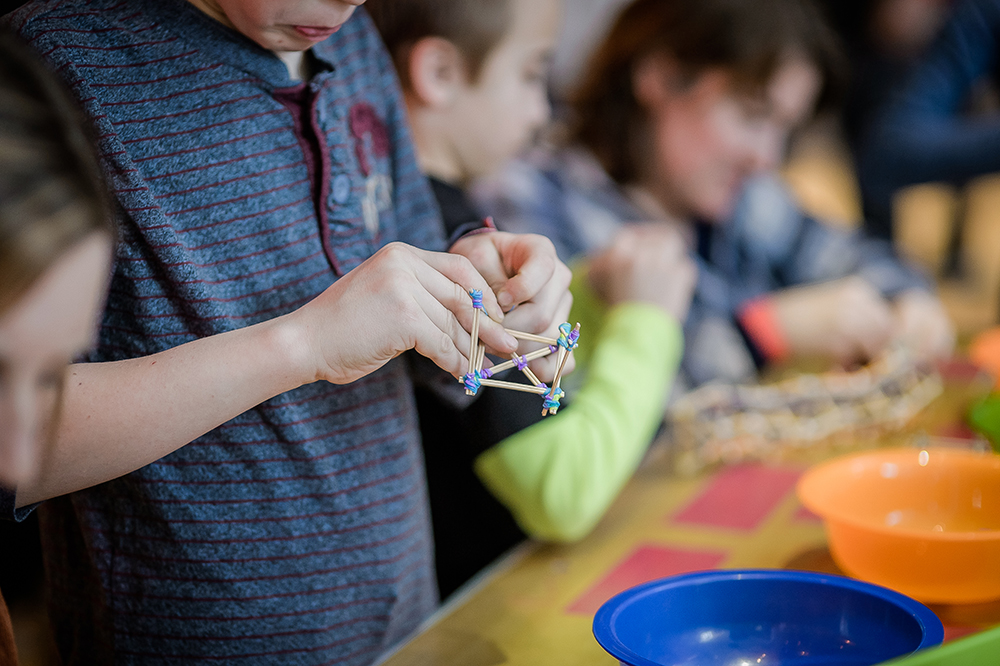
Jacob participated in a summer camp program at SMM. Summer camp programs occupy an intermediary between informal and formal education systems. Taking place in a museum setting and outside of the accountability frameworks common in formal education, summer camps exist in the world of general informal education. But unlike making experiences on the museum floor, summer camps have set curricula including learning goals, progression of skills, and often a take-home project. Instructors at summer camps are paid employees of the museum and, in the case of the instructors in the camp Jacob attended, have a strong background in making and tinkering practices. This week-long, half-day camp allows for greater progression of skill, but did not embody the idea of free choice as youth cannot opt out of activities once at camp. Data were collected at a variety of summer camps offered at SMM, including camps focused on electric circuits, digital game design, and carpentry. Jacob participated in a carpentry-focused camp focused on making a physical maze game.
Finally, Riley and Olivia’s cases both were collected in formal school contexts. The school has a strong existing maker program embedded in the broader curriculum. Students experience maker activities in core subject area classes as well as maker-focused classes such as Creative Design or Digital Media across multiple years of instruction with teachers facilitating and designing the activities.
Riley created a miniature basketball hoop while researchers were onsite, and said that they chose these items for their ease and in the case of the basketball hoop, inspiration from “throwing stuff in the trash.” The teacher in this classroom routinely employed challenges to engage students in making, but during our data collection period, the class engaged in open-design making between challenge projects.
Olivia created a pop-up book based on a book they were reading in French class. From the teacher’s perspective, this project allowed for a less intimidating application of writing and grammar skills the students had recently learned. In assessing the projects, the teacher professed to focus solely on content knowledge, not the technical features of the pop-up book.
Activity features discussion
The youth in this case study viewed the making activity as one where they would work through challenges, while they described other experiences with a debilitating point of view. This analysis suggests that elements of the activity design, especially as they are combined to emphasize a process instead of a fixed product, can influence a youth’s failure mindset. Our analysis suggests that there are several features at play:
- Flexibility: The variety of possible end points within the activity
- Scale: The perception of how macro or micro a failure or mistake is as it relates to the end goal of the product
- Finality: The ability to change, modify, or keep working on a project/product
- Materiality: The availability, variety, and features of materials
- Facilitator influence: The ways in which a facilitator supports or inhibits the features above
Flexibility
Flexibility addresses the breadth or openness as to what a final product could be and how a learner could go about achieving that goal. Many projects we observed had a fixed product goal for learners to achieve, with little room for originality. However, if a learner felt that they could modify the final product to better fit their interests or skill set, they were less likely to feel as if they experienced failure. For example, as Emma worked with the tiny rubber bands and small dowels in the Tensegrity activity, her product goal changed several times over the course of her 65 minutes of making, from something she deemed too hard, to a simpler design, and finally to something new altogether. At one point, she responded “That’s the best part!” to another visitor who shared that they didn’t know what they were making. For this learner, the flexibility of the end product allowed her to explore many options before settling on one path.
Choosing a different route or goal could be seen as avoiding the challenging aspects of an activity that could lead one to fail. Some learners said parts of their activity were “too difficult,” so they modified their goal. In making a cookie cutter, Madison said, “My first idea was to make a whole mermaid, but then that seemed too hard, so I thought maybe just the tail.” Flexibility was also evident in how learners solved problems in construction if there was a predefined goal. In building a pop-up book, Olivia described how she found alternative ways to make the key feature work after finding the example to be too difficult: “…We just decided to kind of adjust it to what we’re comfortable with doing, and that’s efficient for us.” In the end, she found that flexibility in the process helped them to achieve the fixed final product.
Scale
Scale refers to how big or small the maker perceives the failure to be in relation to the overall goal. Youth discussed the idea that some struggles or failures are minuscule (e.g., a broken or incomplete code in the computer program Scratch) and some struggles or failures are global (e.g., a robot falling apart during a presentation). Often, youth did not associate micro failures with the word failure, calling them mistakes, mishaps, accidents, or hurdles. Failure on a grand scale implied totality. In the words of Jacob, who was working on a wooden pinball maze:
"When I’m thinking about making stuff, it’s usually when the purpose of it cannot be completed. So if this was completely impassable, I made this completely impassable. I would count that as a failure. But if you’re able to work around it, I don’t really call it a failure…I call it an inconvenience where the thing still works, but it just either doesn’t look right or…doesn’t work quite right. And a failure is where it just doesn’t work at all.”
Olivia, a youth participating in an in-school maker program, talked about the influence that grading has on her views of failure:
"I feel like this [maker project] is a little more carefree. Even though it’s still a project, I still learn to have fun with it. It wasn’t as serious, but I still manage to…continue on with my work. But in comparison with tests and stuff, it’s just a lot more serious. And it’s scary to think about how it would impact my grade, even though my grade doesn’t define who I am. It’s just really overwhelming to think…that your grade is dropping and everyone is disappointed in you.”
These comments suggest that small-scale failure events can be reframed as part of a process, whereas a complete failure of a system or project can carry the weight of more consequences. However, even those grand failures can be reframed, especially when combined with the opportunity for continued revision.
Finality
Closely related to the idea of scale is the aspect of finality. Finality refers to the ability to change, modify, or keep working on a project or product beyond the expected time frame. Youth reported that failure felt worse when they could not keep working on it or fix problems. Even a macro failure can be persisted through if youth are given the opportunity in terms of time, expectations, or assessment. Often youth with a Failure as Mosaic mindset talked about continually “trying” something until a workaround is found, thus “solving” or “fixing” a failure.
As Riley asserted:
"Always try again, even if it takes you a million tries, more than a million tries. Keep trying again until you get it right….In the Make Room, you have a million chances to try all this.”
Emma explained:
"When I think about failing or failure, I think those are very mean words. I don’t think that anyone ever actually fails at anything. Just because you don’t get it right on the first try doesn’t mean you failed.”
Tensions around time, materials, and assessment created conflicting pressures, especially in formal school environments. To lift the weight and potential anxiety that finality produces, consider building in time for additional improvements or explicitly valuing the creation process in assessments over the final product.
Materiality
Material constraints can encourage problem solving, but limiting materials can also heighten the risk of a debilitating view of failure because a learner may not have enough materials to retry. Riley explained the difference in environments:
"In the Make Room… there [are] basically unlimited resources in here. But in the classroom there [are] 10 glue sticks, 20 scissors, a few pieces of paper, not really all that much stuff. So failing in there would be pretty easy to do, ‘cause you’re like, how am I supposed to make an Abraham Lincoln hat with one piece of paper and no tape.”
Later, Riley spoke about how material constraints forced her to keep trying within what she had available. When she initially couldn’t figure out how to knot and braid yarn to make a basketball hoop, she used the hot glue gun and some scissors to change her design.
The type of material also plays a role in how learners experience failure. Some materials can be manipulated repeatedly (e.g., squishy clay), while other materials are more delicate and require technical finesse (e.g., a piece of conductive tape). Materials also live within a discipline that carries its own set of perspectives on failure. In coding, for example, the practice of debugging encourages a maker to find and fix “bugs” or mistakes. Woodworking encourages precision and planning (“measure twice, cut once”) to avoid mistakes. Disciplines, and the materials used within those disciplines, hold foundational relationships to mistakes, errors, and failures.
Facilitator influence
Finally, the role of the facilitator or educator has consistently been recognized as highly influential in maker experiences, including potentially intervening too early in moments of struggle and failure (Lottero-Perdue 2015; Simpson, Anderson, and Maltese 2019). As a descriptive research project, we did not ask educators to adjust their practice or process in any way. However, educators and volunteers at SMM are trained to support the learning values of risk-taking, the process of discovery, relationship building, and persistence. In the middle school, educators that we observed gave students a great deal of independent work time and encouraged students to ask their peers for help before asking a teacher. In general, across settings educators supported persistence primarily by encouraging experimentation with new ideas, asking questions, and being willing to help when requested. With Emma, the maker activity involved constructing structures with small wooden dowels and small rubber bands, which required repeat fine motor movements. The facilitator allowed Emma to experiment with connecting the wooden dowels until, after five minutes of struggle, Emma asked for advice on how to make the connections. This small act of help—a quick demonstration of a “good” way to use the rubber bands to hold together dowels—allowed Emma to move past the initial struggle of how to connect the pieces and toward the larger, intended struggle of making a structure. In the end, Emma spent over 60 minutes at this tabletop maker experience.
Conclusion and recommendations
Examining maker activities through these spectra allows us to consider the tensions and affordances in how all the small choices of activity design support or constrain learners’ creativity, persistence, and self-efficacy. These youth did not feel they experienced failure in these experiences; for them, this was a positive experience even when they faced challenges.
Educators and program developers should consider where and with what they anticipate youth to struggle during an activity. Some questions to ask when designing or evaluating a maker activity:
- Flexibility: In what ways can the activity accommodate flexibility in the process?
- Scale: What are anticipated challenges, and how influential might they be to the final product?
- Finality: How and where do students see opportunities to continue their work?
- Materiality: How is material availability—in terms of amount and type— related to desired struggle?
- Facilitator Influence: As the facilitator, when and how will you step in to assist a learner?
Making can be used to support any number of skills, whether metacognitive (e.g., critical thinking), social, or discipline specific. Setting intentional goals for learners that match their materials, resources, and limitations will help learners persist with practicing whatever skills you see as important for your learning context. While we began our study wondering if the learning setting would impact learners’ mindsets around failure, we found that the activity features were more influential than where the maker activity occurred. Other research, primarily from out-of-school settings, contributes to the idea that activity features influence the ways in which learners view failure within a making context. Recommendations include supporting learners in viewing making as an iterative process, emphasizing agency and ownership of ideas, creating a learning culture of non-judgement, and recognizing that certain materials (e.g., e-textiles and conductive thread) and disciplines (e.g., computer science) can offer within-task feedback that promotes problem solving and persistence (Ryoo et al. 2015; Estabrooks and Couch 2018; Litts et al. 2016; DeLiema et al. 2018). Our research complements these recommendations by describing five spectra of activity features that educators can use to assess where and when learners are likely to struggle and potentially experience failures.
Like the teacher quoted in the beginning, we suspect that youth failure mindsets can change as a result of maker experiences that includes reflection on struggles, mistakes, and failures. Future research might address how modifying activity features can elicit a Failure as Enhancing or Failure as Mosaic mindset and how mindsets change with experience. We hypothesize that learning context may matter less to students’ views on failure than a supportive culture of learners and educators that explicitly value a making process that anticipates mistakes or failures by emphasizing iteration, a curiosity-driven focus trying things out, and deconstructing failures when they do occur.
Acknowledgments
We would like to thank the many educators and students that contributed to this research project. This material is based upon work supported by the National Science Foundation under Grant No. DRL-1623452. Any opinions, findings, and, conclusions or recommendations expressed in this material are those of the author(s) and do not necessarily reflect the views of the National Science Foundation.
Alice Anderson (aanderson@artsmia.org) is manager of audience research and impact at the Minneapolis Institute of Art in Minneapolis, Minnesota. Megan Goeke (mgoeke@smm.org) is evaluation and research associate at the Science Museum of Minnesota in St. Paul, Minnesota. Amber M. Simpson (asimpson@binghamon.edu) is assistant professor of mathematics education at Binghamton University in Binghamton, New York. Adam V. Maltese (amaltese@indiana.edu) is associate professor of science education at Indiana University in Bloomington, Indiana.



